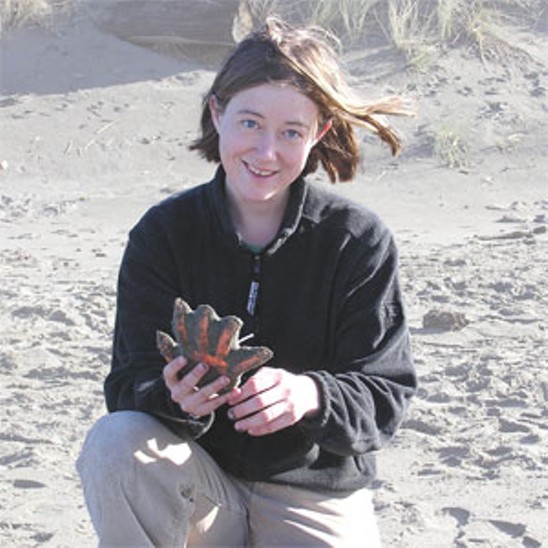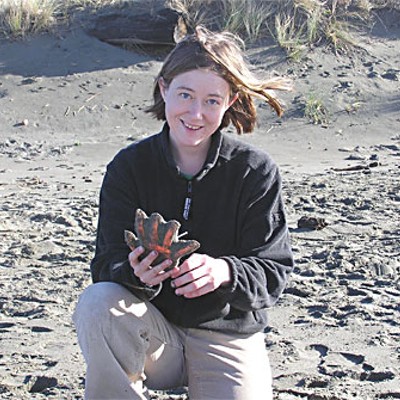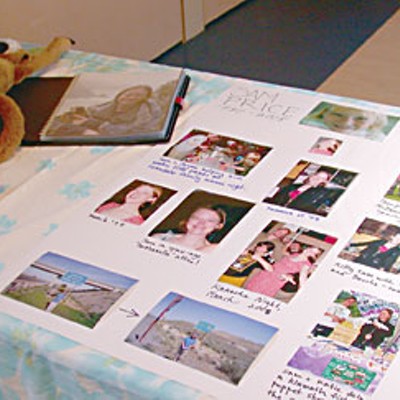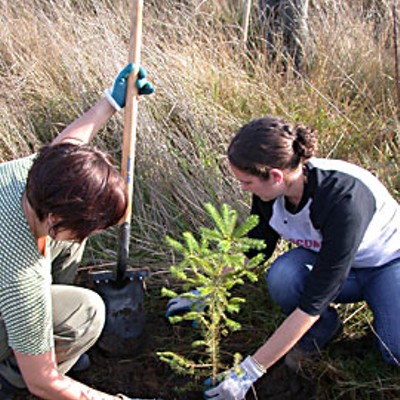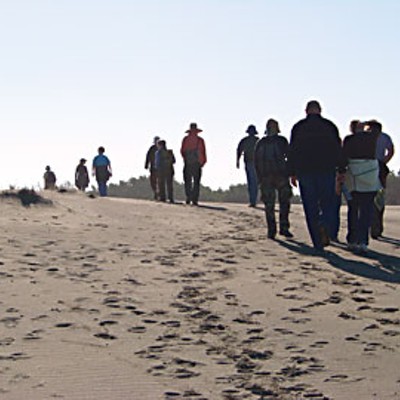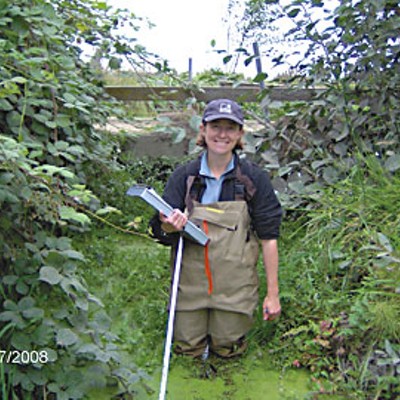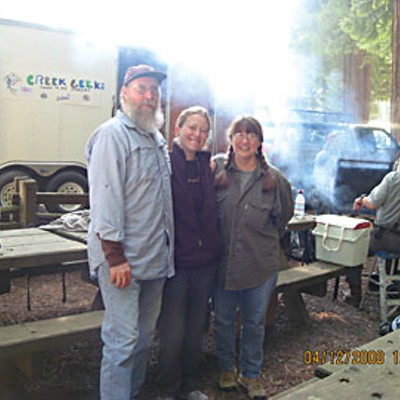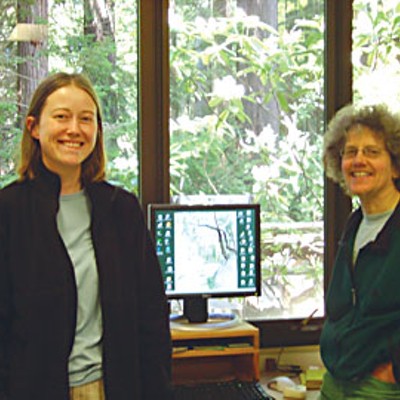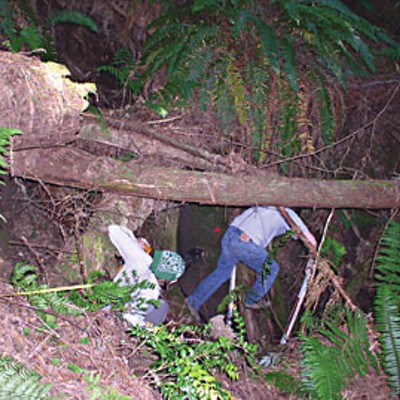[
{
"name": "Top Stories Video Pair",
"insertPoint": "7",
"component": "17087298",
"parentWrapperClass": "fdn-ads-inline-content-block",
"requiredCountToDisplay": "1"
}
]
The early winter sun shone in a glittery slant onto the bright green grass of the field, on the edge of Arcata, where you had to cross muddy braids of earth and streamlets to get to higher ground. There were cows in a distant corner of the field, noses down. The highway and a busy side road were near, and you could hear cars swishing by, but out here in the deep green field the car noise converted to an odd, soothing windscape -- which you accepted because it was expected in this semi-urban wedge of nature.
Shovels scraped and clanged, hitting rock. Crunched into packed earth, ripping grass. Clumps of people, rubber boots halfway up their legs, stomped on the shovels, or bent over freshly dug holes to carefully insert spindly young trees -- roots finally freed of their hardpacked pots.
A couple dozen people came to the field that afternoon of Nov. 16, right after the memorial. Many had never met before. Others had done multiple tree plantings and restoration projects together. Just about all of them had been among the 80-plus people inside the Arcata D Street Neighborhood Center that morning, celebrating a mutual friend.
There, they had talked about Sam: kind, gentle, funny, sensitive, exceedingly reserved, excruciatingly smart, empathetic to a fault -- and a volunteer who put just about all other volunteers to shame. Really. She was a phenomenon, they said. The 28-year-old wildlife biologist, who'd moved to Humboldt in late 2006, would bike miles, rain or shine, to yank out invasive English ivy in the forest or to pull up non-native grass in the dunes or to lead a guided walk.
"One time," Natalie Arroyo had recalled, "Sam came to a restoration day out at Lanphere Dunes [north of Arcata], and she rode her bike there from Eureka. And I remember she was 10 minutes late, and she said, ‘I'm so sorry I'm late.'"
Other times, she'd scrape up cash, which she had very little of, to rent a car to get to a volunteer event. And she'd do all that on the weekend, after a full work week knee-deep in a stream or at the lab or office. And all that's not even half of it.
In the field, Sam's friends, coworkers and fellow volunteers dug holes together. Some sat in a circle around their small planted tree, placing pretty rocks around it and talking. Others kept digging new holes, with vigor. The tree planting, though it would have been done anyway, was now done in Sam's honor.
Some of them had met Sam through the AmeriCorps Watershed Stewards Project (WSP), where she'd done watershed research work for the past two years, first with the U.S. Forest Service's Redwood Sciences Lab in Arcata and later with the state Fish and Game office out of Eureka. Some only knew her through the Friends of the Dunes, a nonprofit group that works to restore native coastal dune habitats and educate people about them. Yet others met her in the Audubon Society, for whom she was the treasurer over the past year and a half. And a few knew her from the Emma Center, a place for abused women to gather for support and to partake in healing arts.
Everyone, upon first meeting her, had seen the obvious: that she "had dimples and freckles, bright blue eyes and an infectious smile," as it said in the obituary her family wrote for the newspapers here and in her Kansas hometown. She was also very, very shy.
"But once you got past the part where she'd sort of look down and bow out, Sam was the sweetest, most darling soul," said Arroyo at the memorial. One time, Arroyo said, Sam even got up during one of their karaoke outings and sang Weird Al.
Others had perceived that she suffered somehow. A rare few knew that it was severe depression.
And there's the true marvel of Sarah Jane "Sam" Price: that, although staggering under the weight of such depression, she engaged full-on as a volunteer in whatever community she lived in, from the day she arrived in it. Often an indifferent community, at that, said Arroyo, a former AmeriCorps volunteer herself and now a planning specialist with the Redwood Community Action Agency's Natural Resources Services Division.
"One of the things I've noticed about this community is the perspective of many Humboldt County residents regarding ‘outsiders': students, new residents, young people who have moved here, that they assume are just tagging along with the weed scene or whatever," Arroyo said in an e-mail to the Journal days before the memorial for Sam.
Dozens of young people like Sam come to town each year, idealistic volunteers living on a marginal stipend and food stamps, enlisted to repair damage done to the landscape. It would be nice if more people acknowledged them, Arroyo said.
But such attention would have just baffled Sam.
"Sam thought she was a loser -- I'm not joking about this," said Thor Holmes, days after the memorial. He and his wife, Elaine, had befriended Sam back in Kansas when she was in college -- well, they'd practically adopted her, he said. "She thought she was a loser and that no one liked her and that no one even noticed her. ... But, there was this roomful of people that were profoundly sorry that they were not going to play with her anymore."
Sam had told friends she was going to a party on Halloween night; it was her favorite holiday. After work on Halloween day, she pedaled from the Fish and Game office in downtown Eureka to the west side of town where she lived in a little apartment.
There wasn't much in it. A small flatscreen TV she'd recently acquired. A computer. Some animal bones, including a bat skeleton that Thor Holmes gave her. Lots of bat fetishes -- she loved bats. Stones. A large fossil scallop from Centerville Beach. Stuffed animals -- "many of them bats," said Thor. A fish poster. And a poster about surviving abuse, as well as a lot of books on the same subject, many with underlined passages.
At some point, she turned on her computer and logged onto a Web site for women who'd experienced violence. There, she had a blog. And she began to write.
Deputy Coroner Charlie Van Buskirk, who investigated Sam's death the next day, said later that as he was walking around her apartment collecting evidence, he moved the computer and it lit up. It had been in sleep mode. The blog entry was still up on the screen -- she hadn't hit the "Send" button.
"She had titled it, ‘I'm in the process of trying to commit suicide,'" Van Buskirk said. Only there were no spaces between the words. She wrote: "Apparentlythebottomrowofmy
keyboarddoesn'twork,
butI'mtakingallof
mypillsandI'mhopingthat
willbeenough."
When the toxicology report came back, it indicated she died from polypharmacy intoxication. There were seven different prescription medications in her system. "Depression seems to be the common theme with them," Van Buskirk said. They'd been prescribed to her at one time or another, and some were old, but it's typical for people to not throw out old meds, he said.
The rest of her suicide note said she hoped she was not hurting anyone. It said she was sorry she wasn't strong enough but that she was never going to get better.
Van Buskirk said he contacted the Web site owners, who wouldn't allow him full access to the site -- to protect the privacy of its users -- and they searched Sam's blog and found an earlier entry from another day, which they shared with Van Buskirk, that he said indicated her intent to commit suicide.
"I also found in her apartment a journal note from some months back," said Van Buskirk, who photographed it. "It's dated 29 April and says, ‘Two positive things a day: 1) I did not kill myself last night. 2) I'm not biting my nails (as much!).'"
"I spoke to her family, and they were aware that she'd been fighting depression for a long time," he said.
Thor and Elaine Holmes found Sam the next day.
"She was supposed to work Saturday morning and then we were going to pick her up on Saturday afternoon," recalled Thor, about a week after the memorial, as he sat inside the vertebrate museum's small prep lab on the HSU campus. He's the collection manager.
The 60-year-old looked tired. Sitting next to him at the long black table in the center of the room, a student, Elizabeth, had arranged in front of her a row of toothless pine marten skulls and jaws, like a macabre audience. She sorted through containers of loose teeth, placed them in pairs of tiny marching parallel lines on the table and then inserted them into their proper sockets.
"Actually," said Thor, "Sam was supposed to start volunteering at the hospital that day, because she was thinking maybe she could be an occupational therapist." He laughed, amazed. "You know, I have never seen anyone try so hard."
Sam had a degree in biology, and a powerful resume -- 3.9 GPA in a revered program at the University of Kansas; fieldwork in Costa Rica, on an Alaskan island and in the prairies of Kansas; volunteering since she was a child; and more. But she apparently recently had given up on getting a good job in her profession -- that is, one that would keep her here in Humboldt, which was feeling like home. Her AmeriCorps service would be up in early December. She needed a job with health insurance -- she'd been seeing a counselor, as well as a neuropsychiatrist who was working with her to find the right combination of medication.
Lately, she had hung her hat on a front-office secretarial position with the AmeriCorps office in Fortuna. She was among the top contenders.
Thor received an e-mail from Sam that Friday, Halloween day, that said: "i didn't get the job, i guess that shows what a mistake it is to share your problems with others. i guess that's all there is to say. i love you, thor.'
She also called the Holmes -- but she often called, multiple times a day, Thor said. And he and Elaine would be seeing her the very next day. And it was Halloween.
"I thought she was just partying away," he said.
On Saturday, they went to her apartment to pick her up to take her to Willow Creek, where they live.
"And I knocked on the door and it just opened," said Thor.
He said he and Elaine could tell she'd been deliberate.
"Sam didn't ‘accidentally' do anything," he said. "She was very methodical, very very thoughtful. She asked a whole lot of questions on the front end to make sure she did the mission correctly when I'd give her a job. "
While he was talking and Elizabeth was sorting teeth, another student had come into the lab. They were there for moral support, Thor said. Sarah sat on a stool opposite the pine marten puzzle and took out her knitting: a set of fingered mittens, halfway done. She, like Elizabeth, would finish her project over the next couple of hours.
Order, patience, examination, completion. On a side table in the lab lay a lineup of chipmunks and squirrels, stretched long, fur still on and eyes stuffed with white cotton; several small, amber-translucent skinned carcasses hung in an open cabinet; a giant green sea turtle skeleton was perched farther down the black table; on a shelf posed half a preserved gray fox, cut lengthwise and its skeleton re-inserted for display; and here was a pine marten, some bighorn sheep horns, a Risso's dolphin skeleton.
The room smelled funky, like wet dog fur. You think that's bad, said Elizabeth.
"If you walk out that way" -- she pointed toward the outside -- "to where we keep the beetles that feed off the flesh before we get to them -- that smell, if you get within 10 feet of that room you smell it the rest of the day."
Thor explained that the Dermestids -- carpet beetles -- are known for their assiduous attention to detail.
"These things are really really cool because they eat dead muscle tissue preferentially," he said. "You can actually put a carcass into the colony and the beetles will eat the muscle tissue, eat eat eat, until they hit ligaments or tendons or cartilage or bone, and then they will stop eating and go find muscle someplace else."
In the controlled environment of that room around the corner, they can put a dead animal in there and, over time, out comes a beautiful new specimen for the collection -- bones, still held together by ligaments, perfectly articulated.
Thor met Sam in 2003 at the University of Kansas in Lawrence. A botany professor told him about an impressive student of hers who loved "bats and cats," and said maybe Thor could give her a job in the university's Museum of Natural History mammal collection, which he managed -- the fifth biggest of its kind in the world.
The Holmes had Sam and the professor over for dinner. Sam seemed shy and retiring. She wandered around their house, looking at things.
"And so, I asked her, 'How is it you became interested in bats?,'" Thor recalled. "And she said, 'Oh I was in Costa Rica doing some food studies with bats.' I said, 'Really? So, what was it you were doing?' And she said, 'Oh, they were doing a fecal analysis. But mostly what I did was just work the nets and capture these bats and put 'em into groups and identify 'em.' And I go, 'So you were identifying Costa Rican bats?' She said, 'Yeah.' So I said, 'Well, what kind of bats were you getting?' And she said, 'Well, we got a lot of Uroderma.' And I'm standing in my front room in Kansas, looking at this tiny little woman -- because, I can't tell you how small a number of people have ever said the word 'Uroderma' to me..."
He grilled her further. "'So what other stuff were you gettin'?' And she goes, 'Oh, you know, several species of Artibeus were coming up' -- and I said, 'That makes sense' -- ‘and a lot of Carollia.' Carollia is, man, an incredibly annoying group of bats because they're hard to tell apart. And so I can remember standing there in my front room and going, 'Carollia? You were catching Carollia?' And she goes, ‘Yeah.' And I said, 'So how do you know what Carollia you were catching?' And this child stood there and said, ‘Well you know if you look at the hair on their forearms, you can actually tell those species apart pretty easily.'"
"And so, my response was, 'Yeah, I'll see you in the museum tomorrow.'"
Her first morning at work, Thor showed her a case of 800 fishers skulls. Each one needed a catalog number written on the cranium and in two places on the lower jaw, as well as a male or female symbol or question mark. Throughout the day, Thor checked on her. Things looked fine, the handwriting was neat. He went home, had dinner, and later that night came back to finish some work.
"And Sam was still sittin' there numbering those goddamned fishers skulls," he said. "And I remember walking in the door and going ‘Jesus, Mary and Joseph! This is supposed to be, like, a semester's worth of work!' And she had worked halfway through the case."
He began noticing she'd come into work some days looking distraught. Once, she was convinced she'd bombed a mammalogy test, so Thor asked the professor how she did and it turned out she'd aced it. And whenever his bosses came into the museum -- "three big, loud guys," he said -- she would visibly quake.
"And, you know, you sit there skinnin' shrews all day long, and so you just start talking to each other," Thor said. "And so I just started asking, you know, so what's broken here?"
She had trouble sleeping, she said. Nightmares. He probed further -- but that's when she told him she couldn't tell him everything because he wouldn't be able to handle it.
"And I said, ‘Really? So you have secrets that are so bad that your friends don't play with you anymore?' And she goes, ‘Yeah. There's no way that if you start talking to people about these things that they will continue to be your friend for 30 days.' And I said, ‘I'll take that bet.'
He won -- jokingly rubbing it in as the days passed: "Day 17, and I'm still your friend! Day 29!"
She told him that, when she was a kid, her father had repeatedly said she "was ugly, that she was stupid, that she was worthless, that he wished that she was a boy -- or, or, that he wished that she were dead," said Thor. She also told him she'd had an abusive boyfriend. And if Thor tried to explore those people's motives, she got angry. "She was quick-tempered," he said. "She didn't like to be judged."
Thor said he figures she was born very sensitive. "And I think that maybe that's why she got so injured by her youth," he said.
But she nurtured others. One time in the prep lab, said Thor, she heard him pissing and moaning about not being able to thread a needle. "And the next morning I came up into the museum and there were little needle threaders all over the prep lab," he said. "Sam saw the little needs in the world and took care of them."
In Sam's senior year at K.U., things almost unraveled: She'd gone on a university-sponsored trip to another town and had been molested there by a local. Thor said Sam and her mom reported it to the university. Afterward, she dropped out of school for a semester. Then she signed back up, and because it was the final semester of her senior year she loaded up on the rest of the units she needed to graduate. Too many units, said the university, and it dropped her financial aid. She appealed, and Thor stormed into the financial aid office in her defense.
The botany professor, Thor said, paid for Sam to see a mental health counselor -- but the counselor was male, which didn't go over well. Thor and Elaine also paid for Sam to get some counseling.
"I just wanted for this big brain to not get lost," he said. "Because she wanted to be a bag lady. Or be a dishwasher -- she thought dishwasher would be a low-pressure job. I mean, she thought the whole world was stressful."
Sam became a regular dinner guest at the Holmes'. Sometimes, said Thor, when you talked to her she'd curl into a fetal position, visibly hurting. He'd tell her, try scream therapy. She'd say, that would disturb the neighbors. So one time he held up a couch cushion and said, here, beat the hell out of this. She knocked it and him over the back of the couch and came around, fists swinging. So he and Elaine bought her a punching bag.
Sam graduated and in July 2006 moved to Humboldt County. She planned to join AmeriCorps' watershed program in Fortuna. The Holmes, meanwhile, who'd lived in Humboldt in the 1970s, were planning to move back to family property in Willow Creek that September.
Thor said, "Sam called every night between July and September -- ‘So when are you guys coming?' -- and I'd go, 'We're coming Sam -- all our stuff's in boxes. We are coming. We're not trying to trick you, man, we are coming.'"
Jessie Brownlee met Sam two and a half years ago at a Friends of the Dunes volunteer coastal naturalist training program. They were both new to Humboldt. They buddied up and led guided walks together -- which was scary, said Jessie, because they both were quiet people.
"And everything Sam did she felt an obligation to do the best job possible," said Jessie. "And so for our first walk we spent hours reading our manual and going out there and staging where we were going to stop and talk and what we were going to talk about."
This summer, they and another friend also had gotten a Fish and Game contract to do restoration work at Ma-l'el Dunes.
"We started out by removing English ivy in the forested part of the dunes," said Jessie. "So we put on propane tanks and carried flame throwers and we walked around and burned non-native grasses. And that was a lot of fun. I remember one day Sam brought her boombox out there and we worked on grasses. That was our best day."
She said Sam was harder than hell to get to know -- she was so very quiet. "She took four months before I even found out she had a family," she said. "She hated her father. We didn't talk about it too much."
They talked about science.
"When we were out hiking and I was in the lead, I would call out 'BS,' and that was a banana slug on the ground, so she would know to look down and avoid stepping on it," said Jessie. "One time we were just talking about banana slugs and why some are yellow and some are spotted and some are really dark, and what their natural defense mechanisms are and why doesn't everything eat banana slugs because they're bright yellow and they're just there?"
That night, late, Sam did some research and e-mailed a report to Jessie: Apparently the slugs' slime is offputting and makes animals throw them up. But some clever animals have learned to roll the slugs up in dirt, first, before eating them.
Jessie noticed that Sam seemed drained, working two jobs and volunteering everywhere. Plus, Sam told her she wasn't sleeping well, and the new medications she was trying merely made her throw them back up.
Jessie figures one big reason Sam worked so hard, even when she was sick, was practicality.
"In a community like this where jobs are scarce, you've gotta get your name and face out there," Jessie said. "You get jobs through networking and knowing people, and we believed it's through volunteering that we would be able to land a job. And, I'm a long way from landing a job seeing as I'm still in school, but that was a really big concern for her. She was really worried about work and whether or not she was going to be able to make it in this community."
But, despite worrying about money, Sam had started giving microloans to women in Third World countries.
"I think she was sending $25 at a time, but I remember one week she'd sent 75 bucks," said Jessie. "And this was a person who didn't have money for herself. And she loved it, she was so excited. She saw it as an investment and she would get the money back, and even if she didn't that it was the right thing to do."
But Jessie's favorite story, in that vein, is the one about Sam taking off work one day, renting a car, and driving a woman she'd met at the Emma Center to the airport in San Francisco.
"And then she turned around and came back the same day," said Jessie. "And so, it was the middle of the night, and she was driving back, and she came up to a mountain lion in the road. And so she immediately pulled over and backtracked. And I remember she said she was pretty scared, approaching that mountain lion, but when she determined that it was dead she threw it in the trunk of the rental car."
She was still about an hour from Eureka, and it was past midnight when she got there. "And she couldn't just unload it in her backyard and she couldn't let it sit bleeding in the rental car, so she continued to drive up to Willow Creek to Thor and Elaine's, and unloaded it there. Because she didn't want it to have died for nothing. She wanted to get it to Thor and somehow get it into the HSU collection."
The lion's skull, however, was too crushed to make a good specimen.
Sam's parents live on 11 acres in the country in Abilene, Kansas. It's the same home Sam lived in from seventh grade through high school, accumulating a posse of pets, many of which are still there: several goats named after Star Trek characters, a wood rat named Sappho, two cats named Pumpkin and Killer (the sweeter of the two), and a silver fox Sam begged her family to buy at an animal sale after a fur farm went out of business. It's named Mulder, after the guy in the X-Files.
Before Abilene, the family moved around a bit -- her father was in the Army. They even lived on Fort Riley, a 100,000-acre military post, for a few years, where both of her parents worked. In fact, while Sam and her three brothers were little, the whole family volunteered as Civil War re-enactors on the post, said her mom, Fiona, by telephone one day in late November.
Fiona still works on Fort Riley, in the museum. An anthropologist, she curates the finds that other scientists bring in from the 800-some archaeological sites on the post.
Sam's father was a policeman and military policeman, and is now retired for medical reasons. Fiona did not feel comfortable talking about his relationship with his daughter.
She said that Sam struggled with severe depression starting in adolescence. They got her counseling. And she said she and her daughter were close until recently.
"If I emailed her, she'd e-mail me back," said Fiona. "But the emails are not very descriptive, they don't encourage me to ask more questions or delve much more into her life. And I think she was trying to keep me away so I wouldn't worry. And she was incredibly sensitive and that made life a lot harder on her."
Fiona said there were many times when Sam seemed happy and normal. But it could be hard to tell.
"She came home for Christmas last year and I thought it went fairly well ... and afterwards got an e-mail from her saying it was a disaster for her, it brought too much stuff back. We probably shouldn't have asked her to come home, we should have probably let her stay away. And she didn't want to hurt anybody, and so she came, and that hurt her instead."
Fiona said her daughter worked hard to improve herself. But she often resisted help. She did let her mom drive with her to Eureka, in 2006, to help her get set up in her new home. But later, when Sam's car broke down, she rebuffed her mom's offers to help her get a new car, said Fiona. She did accept friends' offers of bikes, however.
"She was very stressed about getting a job," said Fiona. "We said, we can help you out financially until you find a job, and she said, no, no, she wanted to stand on her own two feet."
On Halloween, Fiona sent her daughter an e-mail card. "She wrote back to me and said thanks, that she missed me and she missed her cats. And then I never heard from her again."
On Halloween day, Sam had gone out into the field to collect some thermographs, which measure water temperature, from Martin Slough. She'd placed them there earlier in the season. It was just one of the jobs she'd done with Fish and Game through AmeriCorps this past year: fish surveys, red-legged frog surveys, fishermen surveys on the Smith River, organizing a watershed symposium, mapping, cataloguing her mentor Michelle Gilroy's documents library.
She brought the thermographs back to the office. After a while, Gilroy said she noticed that Sam seemed really upset.
"I let her know I was there if she needed help," Gilroy said. "I went in there a little bit later, and she was still a little upset. Something had happened."
Gilroy, who knew about Sam's battle, said she and Sam had an agreement that if Sam was having a hard day she could leave work early. "I told her she comes first," said Gilroy. "And she did take personal time and that was fine -- although I had to reasure her it was fine."
Sam stayed around a little while, that Halloween day. "Bless her heart, she was trying to download the data off the thermographs," said Gilroy.
And then she asked if she could leave early. Gilroy said yes -- and then ran after her to ask if she could drive her home. Sam said, no, she'd ride her bike.
Gilroy wonders if she could have done something different that day. "You go back through things, and torture yourself that way," she said.
Others are wondering too if, or how, they could have stopped Sam from killing herself.
"If I thought something was going on, at all, I would have been out there with her for however long it took," said her mom, Fiona.
"Should I have gone and picked her up?" Thor wondered. "I think I could have talked her out of it. I would have said, ‘Come up and watch the Daily Show. I have chocolate up here.' What move did we miss that could have kept this off?"
Thor and Jessie say Sam had talked recently of trying to find some sort of residential facility where she could live while she got her illness under control. She'd talked to her good friend Chrisse Harnos about it. Chrisse and Sam met in an art therapy class at the Emma Center. Chrisse was a client, like Sam; she later became the center's director, but said she and Sam were mainly friends.
"She was very hurt as a child and, as an adult, that can really wreak havoc on your life," said Chrisse. "Normal stresses become huge stresses. And I know she was working really hard to find her way through that so she could be happy and free."
Sam's family has asked that donations be made in Sam's name to the Friends of the Dunes. But some, like the local Audubon Society, have decided to donate money to the Emma Center. And Chrisse and Jessie have talked about a scholarship in Sam's name. "If she was able to get a car and to have that little bit of a cushion ... a scholarship could lighten somebody's load."
Sam's neuropsychiatrist, Dr. Jerryl Rubin, who couldn't talk about Sam's case specifically for confidentiality reasons, said that a part of the bigger picture is affordable, accessible health care. For example, she related how Sam's therapist had to fight for a long time with the AmeriCorps insurance company to get it to allow Sam to also see her, Dr. Rubin. Eventually, the company approved some visits.
In general, Rubin added, there are always lessons from a suicide. "It's a big decision when someone ends their life," she said. "But what they find is, if you can keep them safe during the interval that they are considering it, for some people -- they see a summer day."
And she said, you must listen when somebody says they're suffering. "A kind word can keep somebody alive."
Thor said he is determined to keep an even sharper eye on the young people around him -- kids, really, who can have such a skewed vision of themselves, and the world.
"There are quiet, gentle, retiring treasures out there," he said. "And one hopes that we will be more alert to them, more receptive to them."
Jessie said that after Sam killed herself, at first she comforted herself by believing it was inevitable. But it wasn't, she decided.
"Sam was lonely," said Jessie, crying over the phone. "She was desperately lonely. She was a loner, and her depression kept her alone and that compounded things. She desperately needed attention and affection and love and support and she looked for it and she asked for it. And no one person could have given that to her. But, collectively, I think that we're all culpable. She did so much for everybody else and I don't know if there's anybody who can say they did as much as they could have. I know I could have done so much more. We all could have. And I think we failed her. I think the whole goddamned world failed her. I don't think she had to die."
Out in the field, where the sun slanted in and traffic whirred nearby and cows chewed in the distance, the planters paused above their freshly dug holes, grabbed the little trees and tugged them from their pots, then remembered: In the container, a young tree's roots become compacted. You had to break up the mass before you planted it in the earth. That way, the roots could wriggle into the new ground and grab hold.
But gently, gently.
When they finished, 60 Sitka spruce and alders were in the ground. Maybe most would grow strong and outcompete the hardy cowfood, the grass. Perhaps, one day, salmon would return to little Campbell Creek. The restorationists had done what they could: removed the tide gates, taken the cows off part of the land, and planted the trees.
Comments (12)
Showing 1-12 of 12
more from the author
-
From the Journal Archives: When the Waters Rose in 1964
- Dec 26, 2019
-
Bigfoot Gets Real
- Feb 20, 2015
-
Lincoln's Hearse
- Feb 19, 2015
- More »
Latest in News
Readers also liked…
-
Through Mark Larson's Lens
A local photographer's favorite images of 2022 in Humboldt
- Jan 5, 2023
-
'To Celebrate Our Sovereignty'
Yurok Tribe to host gathering honoring 'ultimate river warrior' on the anniversary of the U.S. Supreme Court ruling that changed everything
- Jun 8, 2023
